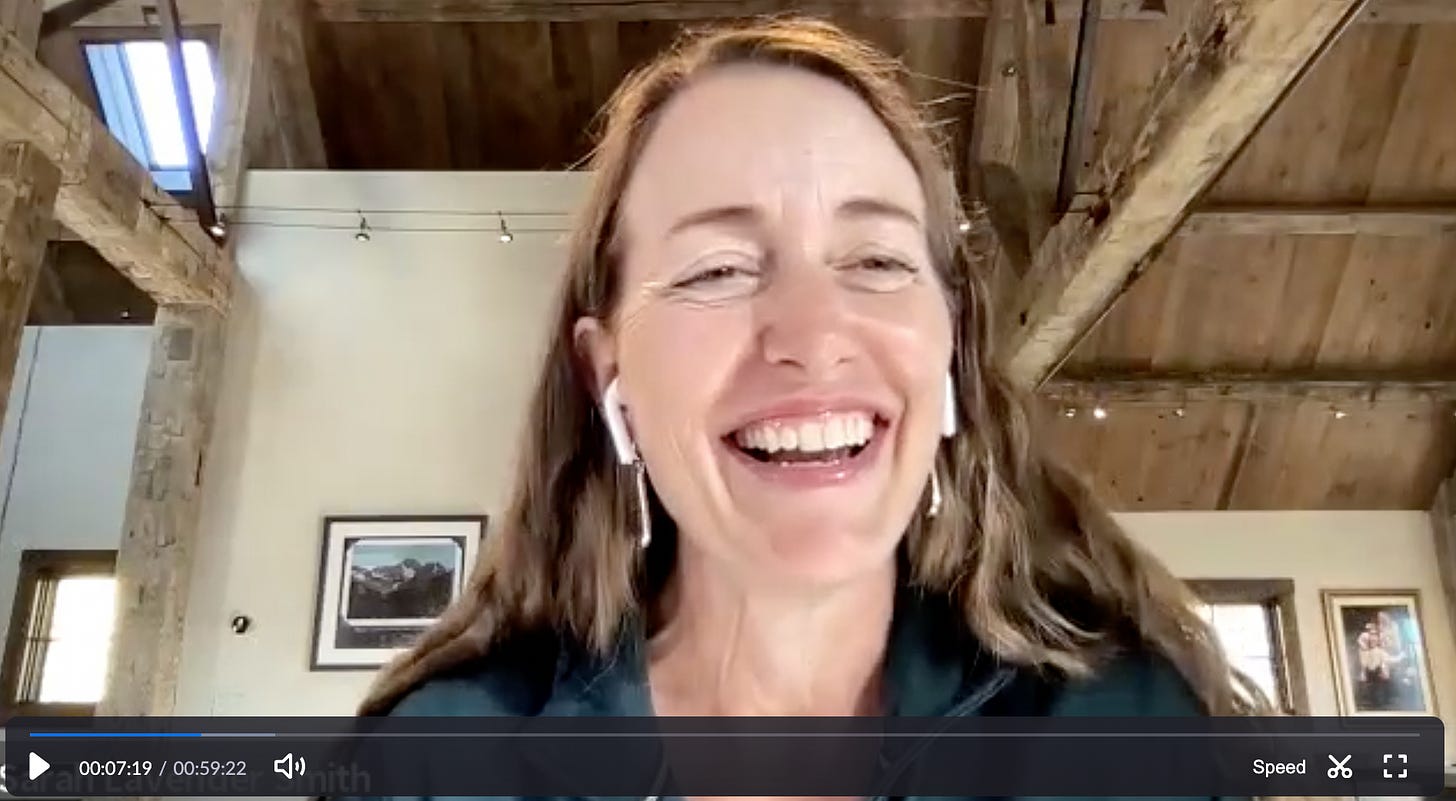Anything Can Happen In the Mountains
A followup on Suzanna Bon's Tor des Géants plus mountain safety essentials
Would you like to listen to this post instead of read it, in case you’re driving, cooking, or on a run? You can hear an audio transcript, recorded in my voice, thanks to Substack’s new voiceover feature that I’m trying for the first time. That’s why you see the new Article Voiceover toolbar above—just click the play button. Please let me know in the comments below if you use this function and what you think of it. (I promise my voice will sound better next time when I’m not congested.)
Hi folks,
This is a bonus post I normally would publish for paid subscribers. I’m sharing it publicly, however, because it contains practical info that I hope might benefit ultrarunners and backcountry trail users at large. Plus, I’d like to show you all what our monthly online meetups are like.
First, you’ll find a Zoom recording from last Wednesday with special guest Suzanna Bon. I wrote about Suzanna in the recent post “A Giant Ultra Like No Other,” which described how at age 58 she nailed the grueling 205-mile Tor des Géants multi-day race in Northern Italy, finishing 10th woman and 115th overall in a field of over 900 starters, fewer than half of whom finished the whole course.
I host these Zooms monthly for paid subscribers. Usually a relatively small number drop in, which fosters good conversation and allows us to get to know one another. I record the session for those who couldn’t make the time. Here’s the link to the recording, and here’s an outline of what we discussed:
Start: chit-chat and welcomes
5:30: shout-outs to people in our group who recently ran notable races
11:30: introduction of Suzanna
13:30: Suzanna on how she’s feeling post-race
15:45: how she managed to keep going for 4 days and 16 hours with less than 6 hours total sleep
17:45: a question about gear and logistics for the Tor des Géants
20:30: a question on cramping and fatigue
24:15: a question on eating and nausea during the event
28:00: Suzanna’s description of how the event’s “life bases” differ from regular aid stations and are even spa-like
30:00: a question about her pack and what she carried
34:45: Suzanna’s thoughts on training in California versus Colorado
37:15: how racing ultras in Europe differs from ultras in the U.S.
42:30: advice on how to get through rough patches and finish
47:45: a question about what draws her to these extra-long endurance events
51:30: advice on how to gain entry into the Tor des Géants
55:20: what’s next for Suzanna, and a wrap-up of our session
I’m really grateful to Suzanna and everyone who took part in this conversation. If you’d like to be a part of these subscriber meetups, or if you’d simply like to support this newsletter, please upgrade your subscription to the supporter level of $6/month. Thank you!
Also, I want to share this link to an article in yesterday’s Colorado Sun, headlined: “Two runners have gone missing in remote Colorado mountains, leading to push for more education.” The subhead reads: “Fitness is not enough to stay safe in remote mountains where risks are amplified.”
If you know me, you know I’m big on wilderness safety and someone who takes a lot of precautions. Normally I write reminders about mountain safety in early summer, as the high country trails reopen. But this warning is timely year-round, and wintertime is a great time to take a Wilderness First Aid course.
Two years ago, I wrote a column for UltraRunning magazine called “Listen To Your Mom: Be Prepared.” It sums up my safety advice, so I’ll reprint it here.
“Anything can happen in the mountains,” I tell my 19-year-old son, Kyle, as I show him how to use the SOS button on my GPS tracking device. When I hand him a windbreaker, he looks at me as if I’m insane, because we’re living through a heat wave and the sky is cloudless.
My son, who does not share my love of running, is so bored and feeling cooped-up by life during the pandemic (summer job opportunity evaporated, minimal parties, the well of new-movie releases running dry) that he surprises me one weekday in July by announcing he’s going to summit the mountain he’s been staring at while lying in bed. He starts to leave the house wearing treadless Vans and a bathing suit with the Metallica logo, carrying only a hand-held water bottle, his phone, and Airpods.
I emit the cry of a panicky mother, “Wait! Don’t go!” and lasso him back to the kitchen to force him into trail-running shoes. He grows visibly impatient as I stuff my husband’s pack with food and a water filtration system, and dodges sideways when I rub sunscreen on his neck. By the time I explain what the small syringe in the first aid kit is for (to irrigate a cut), he squirms as if I’m forcing him to try on clothes in a store dressing room. “I’m outta here,” he says, bolting toward the door.
Kyle texts me a selfie a few hours later, next to the summit’s rocky outcropping, and I experience a pang of love and pride mixed with satisfaction because he’s wearing the windbreaker! When he returns hours later with scratches and dirt covering his legs, having consumed all the food and water from the pack, I sense a new feeling of mutual respect between us.

For any challenging run in the wilderness, ask the following, “Could I take care of myself for at least an hour if I got injured and had to call for help?” Imagine sustaining a significant injury that forced you to sit and wait. Or picture getting hopelessly lost and consequently spending much more time than anticipated on the trail—perhaps past nightfall. Your body temperature would drop. You’d grow hungry and thirsty. Or, you might get disoriented.
Let’s cover the basics to prevent these kinds of scenarios.
Know where you’re going and maintain a line of communication. Many of us who escape to the mountains want to disconnect from devices and reconnect with nature, so I understand the urge to leave the phone behind, but this would be a mistake. Take the following steps:
Download a map of your route and use an app such as Gaia for route-finding.
Put your phone in low-power mode to preserve the battery.
Share your location with a friend so that someone can track your whereabouts.
Program a local rescue number into your phone (this may be the county sheriff’s office or park service), to call for help directly rather than relying on 911.
If cell coverage is spotty, carry a GPS tracking device.
Carry a signaling whistle; three short blasts are recognized as a distress call. Having a whistle to call for help is much better than using your voice, which will give out.
Carry first aid and know how to use it. I can’t overemphasize the value of learning wilderness first aid. My first aid kit fits into a sandwich-size Ziploc bag. It saved me once when a sharp-edged rock slammed into my ankle and gave me a blood-spurting puncture wound.
Carry extra layers for changes in temperature. A lightweight windbreaker, a cheap plastic rain poncho, gloves, and an emergency bivvy all go in my pack. During monsoon season, or when I’m in an ultra that goes past dark, I also bring rain pants and an extra wool base layer.
Bring more calories and fluid than you think you’ll need. Pack a variety of snacks, some containing sodium to replace salt lost through sweating, and take extra in case you’re out longer than expected. I always carry the Katadyn Be Free filter to refill my water bottles at streams.
Take little comfort items that can make a big difference. Small tubes of sunscreen and anti-chafe lube, a bug repellent wipe, and toilet paper in a baggie—to pack out the toilet paper; leave no trace!—are small items that weigh next to nothing but can make your outing much more pleasant.
Carry trekking poles when exploring unfamiliar terrain. My Black Diamond Z Poles often stay folded up in my pack the whole time, but occasionally they are life-savers if I need to ford a storm-swollen stream or navigate a scrabbly slope. They also will help if you roll an ankle and can’t bear your full weight while hiking.
Have a light source if there’s any chance you’ll be out past sunset. Your phone’s flashlight can do in a pinch, but take a headlamp if you’re heading out in the afternoon and might be on the trail past sunset.
Bring a Buff. Perhaps my favorite piece of clothing is the basic Buff. The strip of fabric can shield the neck from sun, warm the ears and head, function as a towel, tissue, bandage, or tourniquet.

If you think that carrying all this gear is overkill, I’ll remind you what I told my son: anything can happen in the mountains.
So that’s it for this post and my first-ever voiceover recording. I’m happily surprised I got this out since I’m on Day 3 of covid, experiencing symptoms including fatigue, congestion, and mental fogginess. I’ll write more about it in Wednesday’s post. For now, I’m resting and getting ready for a big winter storm set to hit tomorrow. Thanks for reading (or listening!) this far.






